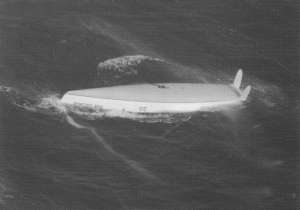- Author
- Periodical, Semaphore
- Subjects
- Ship histories and stories
- Tags
-
- RAN Ships
- HMAS Adelaide II, HMAS Westralia II
- Publication
- December 2007 edition of the Naval Historical Review (all rights reserved)
This article was first published in Semaphore, the newsletter of the Sea Power Centre – Australia, Issue 3 January, 2007.

(Image:Defence)
Safety fears for missing yachtie Bullimore is typical of the headlines that swept across the international news wires in mid-November 2006 when contact was lost with adventurer and yachtsman Tony Bullimore aboard his 102-foot catamaran Doha 2006.
He was en route from the Maldives to Hobart in Tasmania, from where he hoped to embark upon a solo round-the-world voyage in an attempt to break Dame Ellen Macarthur’s 71-day record set in 2005. Fortunately this time Doha 2006 had simply suffered a communications defect and arrived safely in Albany on 20 November before shaping course for Hobart. Turn back the clock ten years to January 1997, however, and it was a very different story, one that nearly ended in tragedy for the intrepid Englishman.
In November 1996, sixteen competitors began the third Vendee Globe Yacht Race from the French port of Les Sables d’Olonne. Only six would finish the race. Unlike the VELUX 5 Oceans Race (formerly known as the BOC Challenge and Around Alone), in which competitors sail pre-determined legs between specific ports, the Vendee Globe, founded in 1989, is a single-handed round-the-world yacht race with no stops and no outside assistance allowed. The Vendee Globe route takes competitors down the Atlantic Ocean until they turn east beneath the Cape of Good Hope for the treacherous passage across the Southern Ocean as they navigate around the Antarctic south of Australia, before rounding Cape Horn for the final leg back to Les Sables d’Olonne.
As soon as the race began the competitors encountered heavy seas in the Bay of Biscay that forced two yachtsmen to retire early. The conditions compelled others to return to the starting point to effect repairs. Having overcome such obstacles, the competitors probably believed that their future journeys would be relatively smooth sailing. But they could not have foreseen the extreme weather that awaited them in the Southern Ocean. Sub-Antarctic waters are notoriously hazardous for smaller vessels, even in the summer months, as the weather is highly variable.
The first Vendee Globe yacht to capsize in the Southern Ocean was Algimouss, skippered by Frenchman Raphael Dinelli. On 26 December 1996, the Australian Maritime Rescue Coordination Centre (MRCC) requested Australian Defence Force (ADF) assistance to search for Dinelli, estimated to be in a position 1100 nautical miles south-south-west of Perth. Algimouss was located later that day by a Royal Australian Air Force (RAAF) P3C Orion aircraft. The yacht was partly submerged and Dinelli was observed to be standing on the deck which was awash with sea water. He scrambled into an air-dropped life raft moments before Algimouss sank. Fellow competitor Pete Goss, in Aqua Quorum, diverted and guided by the crew of another Orion aircraft, successfully manoeuvred his yacht to effect a hazardous rescue of Dinelli the following day.
In the early hours of 6 January 1997 a call came through from race officials reporting that multiple ARGUS beacons, belonging to Thierry Dubois (Pour Amnesty International) and Tony Bullimore (Exide Challenger), had been detected in the Southern Ocean some 1400 nautical miles south-south-west of Perth. The MRCC again called upon the ADF for assistance. As a signatory to the International Convention for the Safety of Life at Sea, 1974, and the International Convention on Maritime Search and Rescue, 1979, Australia is responsible for maritime search and rescue over a vast area of some 52.8 million square kilometres. Australia takes this obligation very seriously.
The Commanding Officer of HMAS Adelaide, Captain Raydon Gates, RAN, was awoken by a telephone call at 0100 (WST) on 6 January 1997 and ordered to prepare his ship to sail. Adelaide departed Fleet Base West (FBW), Fremantle at 1600 that afternoon, after storing ship, recalling crew, and embarking specialist personnel, which included a medical officer, a media contingent, and a chaplain. The ship’s S-70B Seahawk helicopter embarked en route.
Being called upon to deploy to the southern climes at short notice was nothing new for the Royal Australian Navy (RAN). Two years earlier, on New Year’s Day 1995, HMAS Darwin rescued lone yachtswoman Isabelle Autissier from her yacht Ecureuil 900 nautical miles south of Adelaide.




